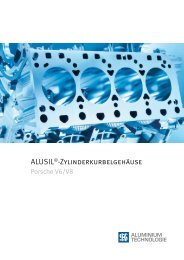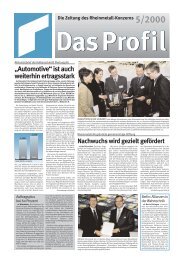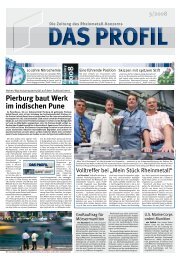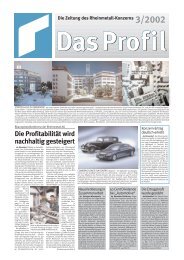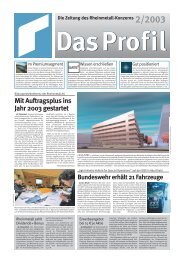PDF [1.1 MB] - KSPG AG
PDF [1.1 MB] - KSPG AG
PDF [1.1 MB] - KSPG AG
You also want an ePaper? Increase the reach of your titles
YUMPU automatically turns print PDFs into web optimized ePapers that Google loves.
Bremen. Interoperability is crucial to the success of<br />
modern-day armed forces. The challenge now is to develop<br />
new capabilities by networking individual military<br />
services. New mission scenarios such as peacekeeping<br />
missions demand such new capabilities<br />
through networked communication, capabilities that<br />
are having a decisive effect on force transformation.<br />
The armed forces of the USA and Nato are currently being<br />
restructured and re-equipped within the framework<br />
Newsline<br />
RDE in Bremen uses NEC experimental environment to test new capabilities<br />
Combined and networked operations<br />
n an experimental NEC environment<br />
Rheinmetall Defence Electronics<br />
GmbH (RDE) of Bremen is<br />
testing how the interoperation of<br />
very different systems could work.<br />
Mission scenarios in which more<br />
extensively automated processes<br />
support the communication between<br />
sensor and weapon systems are being<br />
developed and tried out. At present, it<br />
is often necessary to transfer the data<br />
from various systems manually because<br />
the system interfaces are incompatible.<br />
Network-enabled systems will<br />
help overcome such incompatibilities<br />
in communication.<br />
An attack on a terrorist camp is one<br />
particularly realistic scenario for Network<br />
Enabled Capabilities. One conceivable<br />
solution in future could be that<br />
the reconnaissance data – possibly<br />
coming from an AWACS aircraft – is automatically<br />
transmitted by data link to a<br />
frigate sailing near the coastline. The<br />
frigate could send the information to an<br />
unmanned KZO reconnaissance air vehicle<br />
which can deliver more accurate<br />
images of a potential target. Again by<br />
data link, the UAV can then provide the<br />
data to all other units at the same time<br />
and online. Based on the evaluation in<br />
the operational headquarters, a decision<br />
as to whether the target should be<br />
engaged could then be reached very<br />
quickly because all the information is<br />
already available to all the stations.<br />
Similarly, air surveillance could be<br />
achieved by interlinking airborne and<br />
ground reconnaissance functions in order<br />
to transmit an up-to-date tactical<br />
image to all systems and stations involved<br />
so that an air defence post can<br />
then engage an approaching airborne<br />
target, again largely based on automated<br />
processes. The open architecture of<br />
interfaces including those from other<br />
manufacturers is crucial to the success<br />
of such scenarios.<br />
Communication in a network of this<br />
type can be demonstrated in such an<br />
15<br />
of the force transformation process. In future, armed<br />
forces will operate multi-nationally and in combined<br />
arms, meaning that the armies, navies and air forces<br />
of various nations will increasingly conduct combined<br />
operations in a network. Special new capabilities – socalled<br />
Network Enabled Capabilities (NEC) – play a<br />
critical role in this context: at every echelon sensors,<br />
effectors as well as C3I and support systems will be woven<br />
into a network via an appropriate IT architecture.<br />
experiment and in another much more<br />
sophisticated environment: In this<br />
case, the self-propelled howitzer M109<br />
A2, the Tares combat drone, the Fennek<br />
reconnaissance vehicle with the<br />
observation and reconnaissance<br />
equipment and the unmanned KZO reconnaissance<br />
air vehicle are interlinked.<br />
Additionally, RDE’s TacSi tactical simulation<br />
system (providing the necessary<br />
virtual real-time simulation and a<br />
realistic environment) has been connected.<br />
Like in real life, this shows vehicle<br />
positions, speeds, reconnoitered<br />
targets and weapon effects – in a combined<br />
network of the type to be employed<br />
in future. The experimental environment<br />
is used to identify deficits<br />
and obstacles and to demonstrate the<br />
capabilities of such a configuration.<br />
The results of such experiments are<br />
taken into account for the design of<br />
network systems that will support the<br />
transformation of forces.<br />
Composing: Thorsten Ohmes/RDE


![PDF [1.1 MB] - KSPG AG](https://img.yumpu.com/4218345/15/500x640/pdf-11-mb-kspg-ag.jpg)
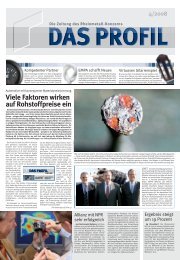
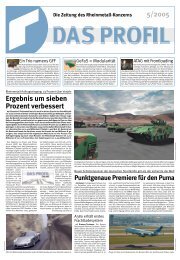
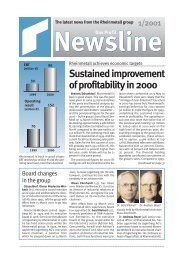

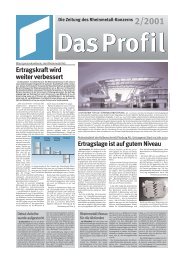
![PDF [1.0 MB] - KSPG AG](https://img.yumpu.com/5513074/1/171x260/pdf-10-mb-kspg-ag.jpg?quality=85)
